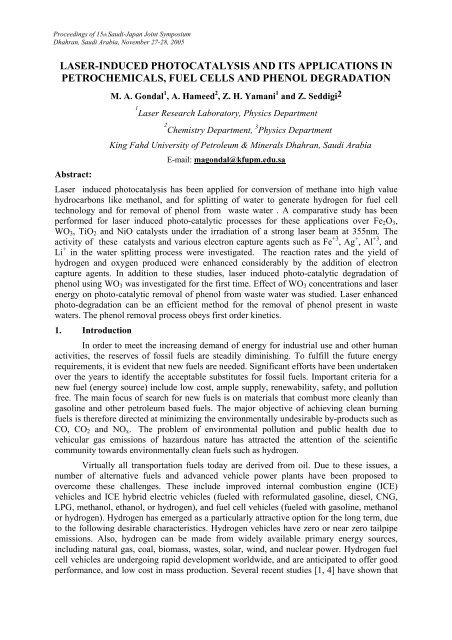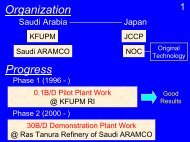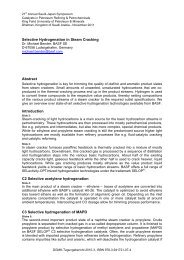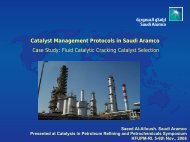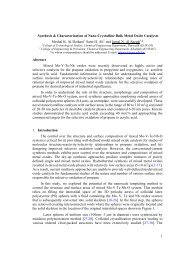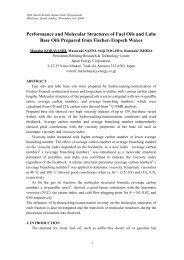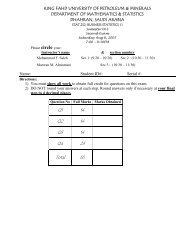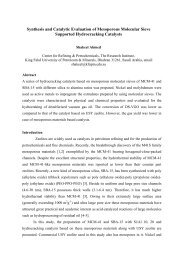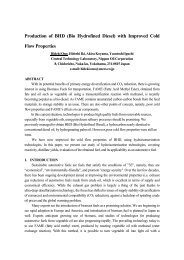Laser-Induced Photocatalysis and its Applications in Petrochemicals ...
Laser-Induced Photocatalysis and its Applications in Petrochemicals ...
Laser-Induced Photocatalysis and its Applications in Petrochemicals ...
Create successful ePaper yourself
Turn your PDF publications into a flip-book with our unique Google optimized e-Paper software.
Proceed<strong>in</strong>gs of 15th Saudi-Japan Jo<strong>in</strong>t SymposiumDhahran, Saudi Arabia, November 27-28, 2005LASER-INDUCED PHOTOCATALYSIS AND ITS APPLICATIONS INPETROCHEMICALS, FUEL CELLS AND PHENOL DEGRADATIONAbstract:M. A. Gondal 1 , A. Hameed 2 , Z. H. Yamani 1 <strong>and</strong> Z. Seddigi 21<strong>Laser</strong> Research Laboratory, Physics Department2Chemistry Department, 3 Physics DepartmentK<strong>in</strong>g Fahd University of Petroleum & M<strong>in</strong>erals Dhahran, Saudi ArabiaE-mail: magondal@kfupm.edu.sa<strong>Laser</strong> <strong>in</strong>duced photocatalysis has been applied for conversion of methane <strong>in</strong>to high valuehydrocarbons like methanol, <strong>and</strong> for splitt<strong>in</strong>g of water to generate hydrogen for fuel celltechnology <strong>and</strong> for removal of phenol from waste water . A comparative study has beenperformed for laser <strong>in</strong>duced photo-catalytic processes for these applications over Fe 2 O 3 ,WO 3 , TiO 2 <strong>and</strong> NiO catalysts under the irradiation of a strong laser beam at 355nm. Theactivity of these catalysts <strong>and</strong> various electron capture agents such as Fe +3 , Ag + , Al +3 , <strong>and</strong>Li + <strong>in</strong> the water splitt<strong>in</strong>g process were <strong>in</strong>vestigated. The reaction rates <strong>and</strong> the yield ofhydrogen <strong>and</strong> oxygen produced were enhanced considerably by the addition of electroncapture agents. In addition to these studies, laser <strong>in</strong>duced photo-catalytic degradation ofphenol us<strong>in</strong>g WO 3 was <strong>in</strong>vestigated for the first time. Effect of WO 3 concentrations <strong>and</strong> laserenergy on photo-catalytic removal of phenol from waste water was studied. <strong>Laser</strong> enhancedphoto-degradation can be an efficient method for the removal of phenol present <strong>in</strong> wastewaters. The phenol removal process obeys first order k<strong>in</strong>etics.1. IntroductionIn order to meet the <strong>in</strong>creas<strong>in</strong>g dem<strong>and</strong> of energy for <strong>in</strong>dustrial use <strong>and</strong> other humanactivities, the reserves of fossil fuels are steadily dim<strong>in</strong>ish<strong>in</strong>g. To fulfill the future energyrequirements, it is evident that new fuels are needed. Significant efforts have been undertakenover the years to identify the acceptable substitutes for fossil fuels. Important criteria for anew fuel (energy source) <strong>in</strong>clude low cost, ample supply, renewability, safety, <strong>and</strong> pollutionfree. The ma<strong>in</strong> focus of search for new fuels is on materials that combust more cleanly thangasol<strong>in</strong>e <strong>and</strong> other petroleum based fuels. The major objective of achiev<strong>in</strong>g clean burn<strong>in</strong>gfuels is therefore directed at m<strong>in</strong>imiz<strong>in</strong>g the environmentally undesirable by-products such asCO, CO 2 <strong>and</strong> NO x . The problem of environmental pollution <strong>and</strong> public health due tovehicular gas emissions of hazardous nature has attracted the attention of the scientificcommunity towards environmentally clean fuels such as hydrogen.Virtually all transportation fuels today are derived from oil. Due to these issues, anumber of alternative fuels <strong>and</strong> advanced vehicle power plants have been proposed toovercome these challenges. These <strong>in</strong>clude improved <strong>in</strong>ternal combustion eng<strong>in</strong>e (ICE)vehicles <strong>and</strong> ICE hybrid electric vehicles (fueled with reformulated gasol<strong>in</strong>e, diesel, CNG,LPG, methanol, ethanol, or hydrogen), <strong>and</strong> fuel cell vehicles (fueled with gasol<strong>in</strong>e, methanolor hydrogen). Hydrogen has emerged as a particularly attractive option for the long term, dueto the follow<strong>in</strong>g desirable characteristics. Hydrogen vehicles have zero or near zero tailpipeemissions. Also, hydrogen can be made from widely available primary energy sources,<strong>in</strong>clud<strong>in</strong>g natural gas, coal, biomass, wastes, solar, w<strong>in</strong>d, <strong>and</strong> nuclear power. Hydrogen fuelcell vehicles are undergo<strong>in</strong>g rapid development worldwide, <strong>and</strong> are anticipated to offer goodperformance, <strong>and</strong> low cost <strong>in</strong> mass production. Several recent studies [1, 4] have shown that
hydrogen is the preferred fuel for fuel cell vehicles. Due to these reasons, the hydrogenproduction is <strong>in</strong> high dem<strong>and</strong> <strong>and</strong> <strong>in</strong>novative <strong>and</strong> alternate methods are be<strong>in</strong>g <strong>in</strong>vestigated forproduction of hydrogen.Recently, the research activities have been focused on the development of noveltechniques for the generation of hydrogen <strong>and</strong> oxygen by splitt<strong>in</strong>g of water [5-10] as water ismost abundant <strong>in</strong> nature. Heterogeneous photo-catalysis is one of the techniques applied forthe generation of H 2 <strong>and</strong> O 2 <strong>in</strong> aqueous solution us<strong>in</strong>g semiconductor catalysts. This photocatalytictechnique is considered to be feasible <strong>and</strong> attractive for practical purposes s<strong>in</strong>ce onecan possibly use natural sun light as an irradiation source <strong>in</strong> the future. Most of the previouswork <strong>in</strong> this doma<strong>in</strong> has been carried out with broadb<strong>and</strong> UV lamps us<strong>in</strong>g pure TiO 2 or TiO 2based semiconductor powders as photo-catalysts [11-13].Recent studies on photocatalysis us<strong>in</strong>g laser, carried out at our laboratory suggestedthat an important parameter which plays a crucial role <strong>in</strong> the enhancement of the activity ofthe catalyst is the irradiation source. Most of the research work reported on photocatalysis isbased on use of conventional lamps [13-18]. Very little work has been carried out onphotocatalysis with lasers [19]. S<strong>in</strong>ce laser light has special properties like monochromaticity,high <strong>in</strong>tensity, <strong>and</strong> low beam divergence, it is of great <strong>in</strong>terest to use laser radiation as anexcitation source to study the activity of photocatalysts. We <strong>in</strong>vestigated the photocatalyticactivity of α-Fe 2 O 3 , WO 3 , TiO 2 <strong>and</strong> NiO as semiconductor catalysts for splitt<strong>in</strong>g of water <strong>in</strong>tohydrogen <strong>and</strong> oxygen <strong>and</strong> for conversion of methanol <strong>in</strong>to hydrogen.2. Experimental Setup DetailsThe setup used to study the photocatalytic conversion of methane <strong>in</strong>to methanol,splitt<strong>in</strong>g of water, conversion of methanol <strong>in</strong>to hydrogen <strong>and</strong> degradation of phenol for wastewater treatment is discussed <strong>in</strong> detail <strong>in</strong> our earlier publications [20-28]. To study thephotocatalytic cativity for these applications over α-Fe 2 O 3 , WO 3 , TiO 2 <strong>and</strong> NiO, all thecatalysts were subjected to identical experimental conditions. While us<strong>in</strong>g laser as a lightsource, it was observed that the important parameters which significantly affects the productyield are: laser energy, amount of catalyst (particle density), stirr<strong>in</strong>g rate <strong>and</strong> laser beamdiameter. The two parameters i.e. stirr<strong>in</strong>g rate <strong>and</strong> laser beam diameter were kept constant forall the studies reported <strong>in</strong> this paper. However, the dependence of products yield on laserenergy <strong>and</strong> amount of catalyst, to identify the maximum yield of Hydrogen <strong>and</strong> Oxygen wasstudied carefully for WO 3 catalyst <strong>in</strong>itially. Once the laser energy <strong>and</strong> amount of catalyst wasidentified for optimum product yield, these two parameters (laser energy & catalystconcentration) were then kept constant for other catalysts for the sake of activity comparison.The destructive effect of focused laser beam was m<strong>in</strong>imized by exp<strong>and</strong><strong>in</strong>g the diameter of thebeam to 1 cm by us<strong>in</strong>g lenses <strong>and</strong> mirrors.The photo-catalytic <strong>in</strong>duced reactions over α-Fe 2 O 3 , WO 3 , TiO 2 <strong>and</strong> NiO were studiedby suspend<strong>in</strong>g an optimized amount (400 mg) of above-mentioned semiconductor powders <strong>in</strong>60 ml of deionized water. This amount (400 mg) was kept constant for all catalysts. Argonwas used as purge gas to remove dissolved gases <strong>and</strong> the progress of the purg<strong>in</strong>g process wasmonitored by analyz<strong>in</strong>g the gas samples from the dead volume of the reaction cell. All theexperiments were performed <strong>in</strong> batches <strong>and</strong> the quantity of evolved gases was estimated byanalyz<strong>in</strong>g the gas samples at regular <strong>in</strong>terval of ten m<strong>in</strong>utes by us<strong>in</strong>g a SHIMADZU GC-17Agas chromatograph equipped with a 30 m, 0.53 mm <strong>in</strong>ner diameter, molecular sieve 5APLOT column <strong>and</strong> a TCD detector. Argon was used as carrier gas. All the catalysts wereexposed to an optimized laser energy of 100 mJ as higher energies were found detrimental.
43211516814567991310121. Nd:YAG <strong>Laser</strong> (1060nm)2. Third harmonic generator (355 nm)3. Beam splitter4. <strong>Laser</strong> energy meter5. Mirror6. Beam diameter controller7. Quartz w<strong>in</strong>dow8. Dead volume of cell9. Effective volume of cell10. Megnatic stirrer11. Megnatic plate12. Gas <strong>in</strong>let13. Liquid sampl<strong>in</strong>g valve14. Gas sampl<strong>in</strong>g valve15. Gas outlet16. Pyrex cellFigure 3.111Experimental Setup for measur<strong>in</strong>g evolvedgases <strong>and</strong> liquid products dur<strong>in</strong>gphotocatalytic process.
3. Results <strong>and</strong> DiscussionThe important applications of laser <strong>in</strong>duced photocatalytic process undertaken at ourlaboratory are the photocatalytic conversion of methane <strong>in</strong>to methanol <strong>and</strong> hydrogen, splitt<strong>in</strong>gof water <strong>in</strong>to Hydrogen <strong>and</strong> oxygen, conversion of methanol <strong>in</strong>to hydrogen <strong>and</strong> phenoldegradation for clean<strong>in</strong>g of waste water.3.1 Photocatalytic conversion of methane <strong>in</strong>to methanolMethane is considered to be a cheap source of energy <strong>and</strong> <strong>its</strong> worldwide reserves arelarge. Global research efforts are under way <strong>in</strong> <strong>in</strong>dustrial as well as academic <strong>in</strong>stitutionsfunded by both private <strong>and</strong> government sectors for the development of methods to convertmethane to useful, more readily transportable <strong>and</strong> storable products such as methanol.Methanol is a desirable product of conversion because it reta<strong>in</strong>s much of the orig<strong>in</strong>al energyof methane while satisfy<strong>in</strong>g transportation <strong>and</strong> storage requirements. Methanol is liquid atroom temperature <strong>and</strong> can be transported to market us<strong>in</strong>g the exist<strong>in</strong>g petroleum pipel<strong>in</strong>e <strong>and</strong>tanker network. It can be used as a fuel or may be converted to other valuable products. Theexist<strong>in</strong>g techniques to convert methane to methanol are not cost effective <strong>and</strong> efficient due topoor selectivity <strong>and</strong> require extreme conditions such as high temperature <strong>and</strong> sophisticatedequipment.The ma<strong>in</strong> aim of this study was to explore <strong>and</strong> develop novel pathways for conversion ofmethane <strong>in</strong>to methanol under mild experimental conditions us<strong>in</strong>g laser light, water <strong>and</strong> asemiconductor photocatalysts such as α-Fe 2 O 3 , WO 3 , TiO 2 <strong>and</strong> NiO.To study the photocatalytic conversion of methane <strong>in</strong>to methanol, the optimized amount ofthe catalyst under study (determ<strong>in</strong>ed by the procedure mentioned earlier), was suspended <strong>in</strong>60 ml of water. Instead of purg<strong>in</strong>g the catalyst suspension with argon, methane was bubbledthrough the suspension for a fixed period of 15 m<strong>in</strong>utes at a fixed flow rate of 100 ml/m<strong>in</strong><strong>and</strong> the cell was sealed at atmospheric pressure. The suspension was illum<strong>in</strong>ated with 355 nmlaser hav<strong>in</strong>g a beam diameter of 10 mm. The progress of the reaction was studied bymeasur<strong>in</strong>g the amount of hydrogen produced <strong>and</strong> change <strong>in</strong> methanol concentration withtime. Separate batch experiments were performed to measure the production of hydrogen <strong>and</strong>methanol.To measure the produced hydrogen, the sample from the dead volume of reaction cell, wasanalyzed at a regular <strong>in</strong>terval of 15 m<strong>in</strong>utes by us<strong>in</strong>g a Shmimadzu gas chromatograph (GC-17A) equipped with a thermal conductivity detector <strong>and</strong> a 30m molecular sieve 5A “PLOT”column. Argon gas was used as carrier at a flow rate of 10 ml/m<strong>in</strong>. To estimate the amount ofmethanol dur<strong>in</strong>g the reaction, liquid samples were drawn from the reaction cell at a regular<strong>in</strong>terval of 10 m<strong>in</strong>utes, centrifuged <strong>and</strong> analyzed by us<strong>in</strong>g a gas chromatograph (supplied byAgilent Technologies) equipped with an FID detector <strong>and</strong> a 2m Chromosorb-101 packedcolumn. Helium gas was used as carrier at a flow rate of 25 ml/m<strong>in</strong>. The <strong>in</strong>jector, column <strong>and</strong>detector temperatures were set at 250 o C, 200 o C <strong>and</strong> 250 o C respectively. Both the gaschromatographs were calibrated by us<strong>in</strong>g self prepared external st<strong>and</strong>ards prior to sampleanalysis. The reproducibility of the process was checked by repeat<strong>in</strong>g the experiments atregular <strong>in</strong>tervals while the reproducibility of the analysis was estimated by runn<strong>in</strong>g thest<strong>and</strong>ards time to time.The progress of methanol formation was monitored by analyz<strong>in</strong>g the liquid samples at regular<strong>in</strong>tervals. The methanol yield as a function of time are plotted <strong>in</strong> Figures 2 & 3 for WO 3 <strong>and</strong>
NiO ccatalysts. It can be observed that <strong>in</strong>itially the methanol yield <strong>in</strong>creases rapidly with thetime, reaches to a maximum value <strong>and</strong> starts decreas<strong>in</strong>g afterwards.160140120Methanol yield (µmol)1008060402000 10 20 30 40 50 60 70 80 90 100Time (m<strong>in</strong>)Figure 2 Methanol yield as a function of time over WO 3120100Methanol yield (µmol)8060402000 10 20 30 40 50 60 70 80 90 100Time (m<strong>in</strong>)Figure 3Methanol yield as a function of time over NiO.
120100Methanol yield (µmol)80604020Figure 400 10 20 30 40 50 60 70 80 90 100Time (m<strong>in</strong>)Hydrogen production <strong>in</strong> the presence <strong>and</strong> absence of methane overWO 3 .3.2 Photocatalytic splitt<strong>in</strong>g of water for generation of hydrogenTo study the photocatalytic splitt<strong>in</strong>g of water, pure (WO 3 , NiO, Fe 2 O 3 <strong>and</strong> TiO 2 )<strong>and</strong> doped photocatalysts, optimized amount of photocatalyst (determ<strong>in</strong>ed from the procedurementioned earlier) was suspended <strong>in</strong> 60 ml of distilled water whereas for water splitt<strong>in</strong>gstudies <strong>in</strong> the presence of metal ions, the optimized amount of the catalyst was suspended <strong>in</strong>60 cm 3 solution of respective metal ion. For this purpose, a 10 ppm solution of each metal ionwas prepared by dissolv<strong>in</strong>g the stoichiometric amount of each metal nitrate <strong>in</strong> 1000 cm 3 ofdoubly distilled de-ionized water. In order to keep the m<strong>in</strong>imum optical effects i.e. selfabsorptionof laser light by the metal ion, the strength of the solutions was selected at 10ppm.An <strong>in</strong>ert atmosphere was produced by purg<strong>in</strong>g argon gas at a high flow rate of 200ml/m<strong>in</strong> for a period of 15 m<strong>in</strong>utes. The purpose of such a high flow rate was to remove all thedissolved oxygen. The progress of argon purg<strong>in</strong>g was studied by analyz<strong>in</strong>g the gas samplefrom the dead volume of reaction chamber. All the reactions were carried out <strong>in</strong> argonenvironment <strong>and</strong> at room temperature. The other important parameters i.e. the stirr<strong>in</strong>g rate<strong>and</strong> beam diameter were kept constant dur<strong>in</strong>g all measurements.SHIMADZU gas chromatograph (GC-17A) equipped with a thermal conductivitydetector (TCD) <strong>and</strong> a 30m molecular sieve 5A “PLOT” column was used to analyze thegaseous products of photocatalytic process. Argon was used as carrier gas <strong>in</strong> GC <strong>and</strong> also aspurge gas to remove dissolved oxygen from the photocatalytic reactor. The <strong>in</strong>jector, column<strong>and</strong> detector temperatures were kept at 50 o C, 50 o C <strong>and</strong> 100 o C respectively. Keep<strong>in</strong>g <strong>in</strong> viewthe high concentration of O 2 <strong>in</strong> the air, the product gases were analyzed by carefullyremov<strong>in</strong>g 100µl of the sample from the dead volume of the cell by us<strong>in</strong>g a gas tight syr<strong>in</strong>ge.
The amount of produced gases were determ<strong>in</strong>ed by analyz<strong>in</strong>g a gases st<strong>and</strong>ard, provided bySCOTTY, Engl<strong>and</strong>, conta<strong>in</strong><strong>in</strong>g 1.0 Mol% of each gas <strong>in</strong> nitrogen base. Severalreproducibility tests were performed over a range of various irradiation times. Theuncerta<strong>in</strong>ty <strong>in</strong> the measurement of H 2 <strong>and</strong> O 2 yield was found to be less than ±3% which wasacceptable for the purpose of present studies.The yield of evolved gases (mmol) as a function of laser exposure time are presented<strong>in</strong> figures 5, where a gradual <strong>in</strong>crease <strong>in</strong> O 2 <strong>and</strong> H 2 yield with time can be observed. The rateof production of both gases i.e. H 2 & O 2 follows the similar pattern. The yield of hydrogen <strong>in</strong>presence of metal ions for WO3 is presented <strong>in</strong> figure 6.The comparison of hydrogenproduction for four catalyst is presented <strong>in</strong> Figure 7.2.5Hydrogen2OxygenGase evolved (mmol)1.510.500 10 20 30 40 50 60 70 80 90 100Time (m<strong>in</strong>)Figure 5Hydrogen <strong>and</strong> oxygen evolution with time over WO 3 through water splitt<strong>in</strong>g.54.543.5WO3Ag+Fe+3Li+O 2 evolved (mmol)32.521.510.5Figure 600 10 20 30 40 50 60 70 80 90 100Time (m<strong>in</strong>)Hydrogen production over WO 3 <strong>in</strong> the presence of metal ions by water splitt<strong>in</strong>g.
4.5H 2 evolved (mmol)43.532.521.5α-Fe2O3WO3TiO2NiO10.500 10 20 30 40 50 60 70 80 90 100Time (m<strong>in</strong>)Figure 7 Comparison of hydrogen production over various photocatalysts by water splitt<strong>in</strong>g.3.3 <strong>Laser</strong> <strong>in</strong>duced photocatalytic degeradation of phenol <strong>in</strong> waste waterA large amount of phenol is produced <strong>and</strong> used annually worldwide. The largests<strong>in</strong>gle use of phenol is <strong>in</strong> the production of plastics, but it is also used <strong>in</strong> the synthesis ofcaprolactam, a precursor for nylon 6 <strong>and</strong> other man-made fibers [29]. Phenolic compoundsare among the most prom<strong>in</strong>ent ground water contam<strong>in</strong>ants [30]. Widespread contam<strong>in</strong>ation ofwater by phenol has been recognized [31] as an issue of grow<strong>in</strong>g concern <strong>in</strong> recent years.Phenol is a carc<strong>in</strong>ogen to humans <strong>and</strong> is of considerable health concern, even at trace(0.001mg/litre) concentrations. Hence the treatment of waste water conta<strong>in</strong><strong>in</strong>g phenol isessential.Many techniques have been used for remov<strong>in</strong>g <strong>and</strong> degradation of phenoliccompounds <strong>in</strong> wastewater. They <strong>in</strong>cluded, adsorption [29], biodegradation [30, 31] extractionby liquid membrane [32] <strong>and</strong> oxidation [32, 33]. The oxidation of phenol by several oxidiz<strong>in</strong>gagents such as ozone, UV <strong>and</strong> hydrogen peroxide has been extensively studied [34]. Apartfrom these studies, <strong>in</strong> recent years there has been <strong>in</strong>creas<strong>in</strong>g <strong>in</strong>terest <strong>in</strong> the use of catalyticwet oxidation [35] <strong>and</strong> wet oxidation [36] for phenol removal. However those methods havesome disadvantages <strong>and</strong> limitations. Susta<strong>in</strong>ability of catalytic wet oxidation technologydepends on k<strong>in</strong>etic regime <strong>in</strong> which the catalyst life would compromise to <strong>its</strong> cost. Recently ithas been reported [37, 38] that total conversion of phenol to CO 2 <strong>and</strong> H 2 O was achievedwhen the plat<strong>in</strong>um surface was almost oxidized <strong>in</strong> which it resulted <strong>in</strong>to catalyst deactivation.Heterogeneous photocatalysis us<strong>in</strong>g semiconductor catalyst under UV irradiation is highlysuccessful <strong>in</strong> m<strong>in</strong>eralization of phenol. Photo catalysis depends on redox processes tak<strong>in</strong>gplace on the surface of the semiconductor/solution <strong>in</strong>terface upon irradiation ofsemiconductor particles with laser light of proper energy (wavelength), higher than the b<strong>and</strong>gap[20-28]. The production of electron- hole pairs is essential s<strong>in</strong>ce these species are capable
3.5Absorbance32.521.5Time= 0 MTime=15 MTime= 30MTime= 60 MTime=75 M10.50190 210 230 250 270 290 310Wavelength(nm)Figure 8 Typical UV absorption spectra of the degradation of phenol at laser exposuretimes rang<strong>in</strong>g from 0 to 75 m<strong>in</strong>utes recorded with UV spectrometer.7060Phenol concentration50403020100 mg200 mg300 mg1000 5 10 15 20 25Time(m<strong>in</strong>utes)Fig.9 The dependence of the removal of phenol on the concentration of the WO 3catalyst. Here the concentration of WO 3 was varied from 100 mg to 300 mg.
References1. J. Ogden, Int. J. of Hydrogen Energy, 24 (1999) 709.2. C. E., Thomas, I. F. Kuhn, B. D. James, F. D. Lomax, <strong>and</strong> G.N. Baum, Int. J. ofHydrogen Energy, 23 (1998), No. 6, 1998.3. Maruthamuthu, P., M. Ashokkomar, K. Gurunathan, E. Subramanian, M.V.C. Shastri,Int. J. Hydrogen energy, 14 (1989) 525.4. Maruthamuthu, P., M. Ashokkomar, Int. J. Hydrogen energy, 14 (1989) 275.5. T. Ohno, D. Haga, K. Fujihara, K. Kaizaki, M. Matsumura, J. Phys. Chem. B 101(1997) 6415.6. K. Sayama, H. Arkawa, J. Chem. Soc., Chem. Commun. (1992) 1507. K. Yamaguchi, S. Sato, J. Chem. Soc., Faraday Trans. 1 81 (1985) 1237.8. T. Kawai, T. Sakata, Chem. Phys. Lett. 72 (1980) 87.9. K. Domen, A. Kudo, T. Onishi, J. Catal. 102 (1986) 92.10. K. Sayama, H. Arkawa, J. Phys. Chem. 97 (1993).11. T. Ohno, D. Haga, K. Fujihara, K. Kaizaki, M. Matsumura, J. Photochem. Photobiol.A: Chem. 118 (1998) 41.12. K. Sayama, R. Yashoda, H. Kusama, K. Okabe, Y. Abe, H. Arkawa, Chem. Phys.Lett. 277 (1997) 387.13. Hoffmann, M.R., S.T. Mart<strong>in</strong>, W. Choi, D. Bahnemann, Chem. Rev., 95 (1995) 69.14. Bamwenda, G.R., T. Uesigi, Y. Abe, K. Sayama, H. Arkawa, Appl. Catal. A, 205(2001)117.15. Blake, D.M., Bibliography of work on the photocatalytic removal of hazardouscompounds from warter <strong>and</strong> air, Report: NREL/TP-340-22197 (1997), NationalRenewable Energy Laboratory, Golden, Co.16. Serpone, N., E. Pelizzetti, (Eds.), <strong>Photocatalysis</strong>, Fundamentals & <strong>Applications</strong>,Wiley, New York, 1989, p. 169 & p. 369.17. Bamwenda, G.R., H. Arkawa, Appl. Catal. A, 210 (2001) 181.18. Fox, M.A., M.T. Dulay, Chem. Rev., 93 (1993) 341.19. C.E. Taylor, R.P. Noceeti, Catal. Today, 55 (2000) 259.20. M. A Gondal, A. Hameed, Z.H. Yamani <strong>and</strong> A. Al-Suwaiyan, Chem. Phy. Lett. 385(2003)111.21. M. A Gondal, A. Hameed , Z. H. Yamani, Energy Sources 27(2005) 1151.22. M. A. Gondal, A. Hameed, Z.H. Yamani <strong>and</strong> A. Al-Suwaiyan, Appl. Catal. A, 268(2004) 159.23. M. A. Gondal, A. Hameed , Z. H. Yamani <strong>and</strong> A. Arfaj, Chem. Phys. Letters , 392(2004) 377.24. M. A. Gondal, A. Hameed , Z. H. Yamani, J. Molecular Catal. A, 222 (2004) 259.25. A. Hameed, Gondal, M. A. <strong>and</strong> Z. H. Yamani, Catal. Commun. , 5 (2004)715.
26. H. Yahaya, M. A. Gondal , A. Hameed , Chem. Phys. Letts, 400 (2004) 206.27. M. A. Gondal, A. Hameed, <strong>and</strong> Z. H.Yamani (2005), Energy Sources, 27(2005)1151.28. M. A.Gondal, A. Hameed <strong>and</strong> A. Al-Suwaiyan, Appl. Catal. A, 243 (2003) 165.29. A. Idres <strong>and</strong> K. Saed, Global Nest : Int. J. 4 (2002) 139.30. S. Parra, S.E. Stanca, E. Guasaquillo <strong>and</strong> K. R. Thampi, Appl. Catal. B: Environ. 51(2004)107.31. S. Lathasree, A. N. Rao, B SivaSankar, V. Sadasivam <strong>and</strong> K. Rengaraj, J. Mol.Catal. A 223 (2004) 101.32. E. Mil<strong>and</strong>, M. R. Smyth <strong>and</strong> C.O. Faga<strong>in</strong>, J. Chem. Technol. <strong>and</strong> Biotechnol. 67(1996) 227.33. Z. Wu <strong>and</strong> M. Zhou, Environ. Sci. & Technol. 35 (2001) 2698.34. S. H. L<strong>in</strong>, C. L. Pan, <strong>and</strong> H.G. Leu, J. Hazardous Mater. 65 (1999) 289.35. C. Canton, S. Esplugas, <strong>and</strong> J. Casado, Appl. Catal. B: Environ. 37 (2002)1320.36. F. J. Benitez, J. Beltran-Heredia, J. L. Acero, <strong>and</strong> F. J. Rubio, J. Chem. Technol. <strong>and</strong>Biotechnol. 76 (2001) 312.37. N. Crowther <strong>and</strong> F. Larachi, Appl. Catal. B: Environ. 46 (2003) 293.38. D. V. Prakash, <strong>and</strong> V. M. Vijaykumar, Adv. <strong>in</strong> Environ. Res. 6 (2002) 429.(2005) 99.


